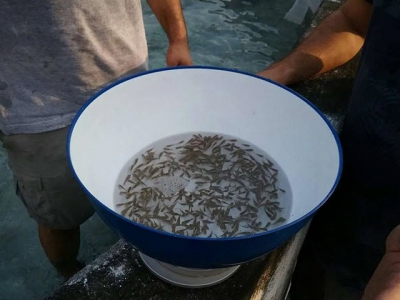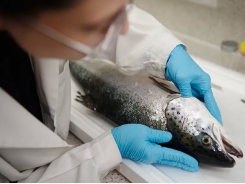New study shows vertical transmission of tilapia lake virus

A study, published in the journal Aquaculture, has provided further evidence that tilapia lake virus (TiLV) can be transmitted from infected broodstock to fertilised eggs. Analysis of infected broodstock indicated that the virus causes systemic infections that impact the liver, kidneys, spleen, brain, heart and connective tissues. Researchers also isolated the virus in the gonads and egg cells of the broodstock.
Recent evidence has shown that the tilapia lake virus can transfer from parents to offspring. Photo Spring Genetics
Further testing demonstrated that the infected egg cells produced infected in vitro zygotes. Based on these results, researchers hypothesised that after initial exposure, the virus spreads to different organ systems through the fish’s circulatory system.
Background
Tilapia lake virus is an infection that affects both farmed and wild tilapia. Infections have been reported in Asia, Africa and South America. Previous research has confirmed that the virus is waterborne and can be transmitted between fish through cohabitating. The virus has a high mortality rate (in some cases up to 90 percent) and is most damaging to juvenile tilapia populations. The virus can also cause sub-clinical infections, where the fish is infected and can pass on the virus without showing any outward symptoms.
The study
The researchers wanted to clarify whether TiLV can transfer from infected broodstock to their reproductive organs and progeny. In order to test this question, the researchers experimentally infected three pairs of tilapia broodstock with an intramuscular injection of TiLV strain NV18R. Two broodstock pairs received a saline injection as a control. The fish in the experimental group were asymptomatic for 6 days after infection, even though tests indicated that the fish carried the virus.
The researchers induced spawning and fertilised the eggs in vitro. They observed the fertilised eggs at 3, 12 and 64 hours after collection to observe how the zygotes developed. The researchers euthanised the tilapia and analysed their internal organs and tissues.
Results
When the fertilised eggs were subjected to PCR, cell culture and in situ hybridisation (ISH), a majority of the fertilised eggs from the experimental group had TiLV NV18R strain in the cells. The fertilised egg cells from the control fish showed no evidence of infection.

Previous research has demonstrated that the virus is waterborne, and can pass between cohabitating fish. Photo Blue Ridge Aquaculture
When the researchers examined the internal organs of the infected broodstock with PCR, the organs showed systemic TiLV infections. Results from ISH showed that the virus moved from an intramuscular injection to the connective tissues, liver and reproductive organs of the experimentally infected fish. The virus was also detected in the females’ egg cells. The control group showed no signs of TiLV.
Based on this result, the researchers hypothesise that the virus infects the organs via the circulatory system. Tissue areas close to blood vessels are probably the initial targets of infection. After exposure, the virus quickly spreads to neighbouring cells and can spread to any organs that receive an arterial blood supply.
When examining tissue samples from the liver and reproductive organs, the researchers note that the infection appears to be in the lymphocytes (a type of white blood cell). From this data, they speculate that lymphocytes are infected with TiLV during the initial immune response – the same infection process as influenza.
When exploring the effects of the virus on the tilapia’s reproductive organs, the researchers conclude that ovarian tissue was more adversely affected than testes. This was because though testicular tissue showed a positive PCR result, the infection was not detected in sperm cells. This indicates that infection in the experimental fertilised eggs originated in oocytes, not sperm.
Based on the data, the researchers speculate that TiLV causes a systemic infection in tilapia broodstock that can be transmitted vertically to fertilised egg cells.
Recommendations
In this case, the researchers urge producers to use TiLV-free broodstock. They also recommend testing both seed and fertilised eggs to make sure they aren’t infected. This will prevent the disease from proliferating in breeding programmes.
They also recommend studying whether infected fertilised eggs translate into infected fry, fingerlings or juveniles. They stress that understanding the disease pathogenesis and transmission will help strengthen prevention efforts.
Related news
Tools

Phối trộn thức ăn chăn nuôi

Pha dung dịch thủy canh

Định mức cho tôm ăn

Phối trộn phân bón NPK

Xác định tỷ lệ tôm sống

Chuyển đổi đơn vị phân bón

Xác định công suất sục khí

Chuyển đổi đơn vị tôm

Tính diện tích nhà kính

Tính thể tích ao









 AMR in aquaculture: a fish…
AMR in aquaculture: a fish…  Researchers look to new ways…
Researchers look to new ways…